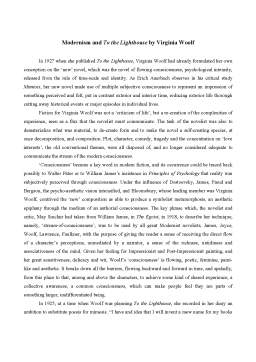Extras din referat
In 1927 when she published To the Lighthouse, Virginia Woolf had already formulated her own conception on the ‘new’ novel, which was the novel of flowing consciousness, psychological intensity, released from the rule of time-scale and identity. As Erich Auerbach observes in his critical study Mimesis, her new novel made use of multiple subjective consciousness to represent an impression of something perceived and felt, put in contrast exterior and interior time, reducing exterior life thorough cutting away historical events or major episodes in individual lives.
Fiction for Virginia Woolf was not a ‘criticism of life’, but a re-creation of the complexities of experience, seen as a flux that the novelist must communicate. The task of the novelist was also to dematerialize what was material, to de-create form and to make the novel a self-creating species, at once decomposition, and composition. Plot, character, comedy, tragedy and the concentration on ‘love interests’, the old conventional themes, were all disposed of, and no longer considered adequate to communicate the stream of the modern consciousness.
‘Consciousness’ became a key word in modern fiction, and its occurrence could be traced back possibly to Walter Pater or to William James’s insistence in Principles of Psychology that reality was subjectively perceived through consciousness. Under the influence of Dostoevsky, James, Freud and Bergson, the psycho-aesthetic vision intensified, and Bloomsbury, whose leading member was Virginia Woolf, contrived the ‘new’ composition as able to produce a symbolist metamorphosis, an aesthetic epiphany through the medium of an authorial consciousness. The key phrase which, the novelist and critic, May Sinclair had taken from William James, in The Egoist, in 1918, to describe her technique, namely, ‘stream-of-consciousness’, was to be used by all great Modernist novelists, James, Joyce, Woolf, Lawrence, Faulkner, with the purpose of giving the reader a sense of receiving the direct flow of a character’s perceptions, unmediated by a narrator, a sense of the richness, untidiness and associativeness of the mind. Given her feeling for Impressionist and Post-Impressionist painting, and her great sensitiveness, delicacy and wit, Woolf’s ‘consciousness’ is flowing, poetic, feminine, paint-like and aesthetic. It breaks down all the barriers, flowing backward and forward in time, and spatially, from this place to that, among and above the characters, to achieve some kind of shared experience, a collective awareness, a common consciousness, which can make people feel they are parts of something larger, undifferentiated being.
In 1925, at a time when Woolf was planning To the Lighthouse, she recorded in her diary an ambition to substitute poesis for mimesis. “I have and idea that I will invent a mew name for my books to supplant ‘novel’. A new –by Virginia Woolf. But what? Elegy?” The new novel, To the Lighthouse, did indeed prove to be an elegy, for her father, Leslie Stephen, the literary critic and biographer, and for her mother, Julia Stephen, a legendary pre-Raphaelite beauty. In Sketch of the Past, she recalls that the writing of the novel had been cathartic, a form of therapy in which she came to terms with her mother’s loss by deliberately recalling her presence in a portrait that, according to her sister Vanessa, was wonderfully lifelike. The pain of that loss, indirectly experienced by Lily Briscoe as ‘a hardness, a hollowness, a strain…to want and not to have – to want and want’, was at last laid to rest.
The book is structured as a triptych: the first part, “The Window”, gently celebrative, limits itself to depict the only September evening spent by the Ramsays and their friends at a holiday home in the Hebrides, the second part, “Time Passes”, evokes the decay of the house over the period of the Great War, during which two of the Ramsay family die, and Mrs. Ramsay, and the third, “The Lighthouse” treats a world of absence redeemed by art.
All throughout the first section, Mrs. Ramsay is continuously ‘framed’, either within the boundaries of Lily’s painting or in the window through which Lily sees her. She is the character whose portrait is the subject of the novel, caught, and framed within the shadow of memory, trapped within the field of male desires and fantasies. If the ideal of manhood involves reaching destinations and conquering heights, and is a constant process of becoming, women by contrast are expected to impress by their qualities of being, by beauty rather than intellect, by serenity rather than achievement. For instance, Minta feels the magic surround her as she comes in to dinner: ‘she wore her golden haze, sometimes she had it; sometimes not’, while the eldest daughter is growing beautiful.
Nevertheless, Woolf’s struggle to liberate herself from this patriarchal ideal of womanhood and exorcize many of the Victorian values her parents magnificently embodied, produces Lily Briscoe, who disapproves with Mrs. Ramsay’s values, while she deeply loves her. She refuses to co-operate with her and is rejecting that traditional code of behaviour, which requires a woman to accommodate a male ego, to allow a young man at dinner ‘to expose and relieve the thigh bones, the ribs, of his vanity, of his urgent desire to assert himself’. Lily is not only the figure of the artist in the novel, but also a double for the author who had herself experienced a desperate yearning for and ultimate rejection of what her mother had stood for, Victorianism.
Preview document
Conținut arhivă zip
- Modernism and 'To the Lighthouse' by Virgina Woolf.doc













